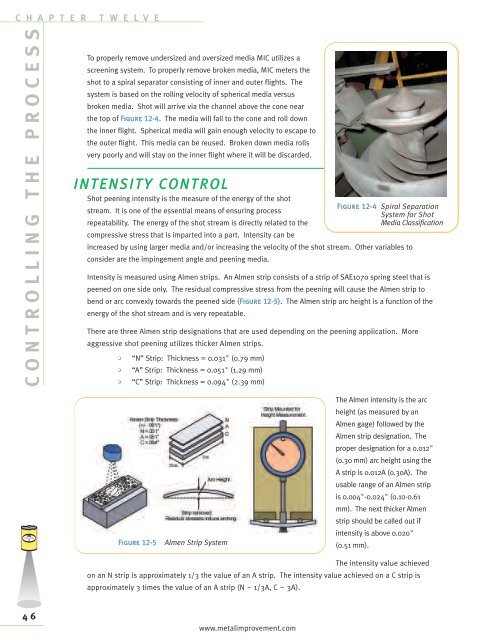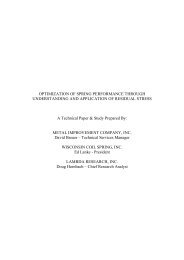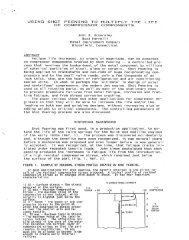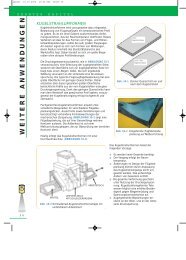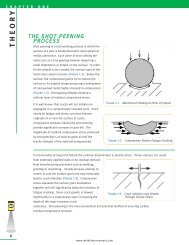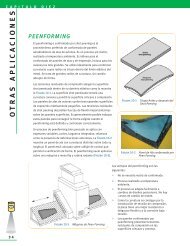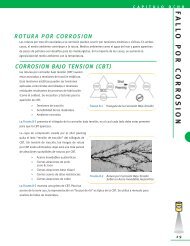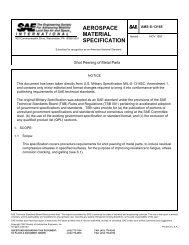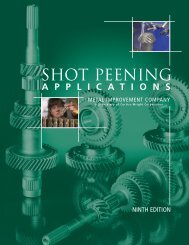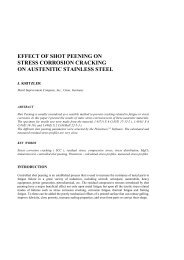shot peening residual stress - Metal Improvement Company
shot peening residual stress - Metal Improvement Company
shot peening residual stress - Metal Improvement Company
You also want an ePaper? Increase the reach of your titles
YUMPU automatically turns print PDFs into web optimized ePapers that Google loves.
C H A P T E R T W E L V E<br />
C ONTROLL ING THE PROCESS<br />
46<br />
To properly remove undersized and oversized media MIC utilizes a<br />
screening system. To properly remove broken media, MIC meters the<br />
<strong>shot</strong> to a spiral separator consisting of inner and outer flights. The<br />
system is based on the rolling velocity of spherical media versus<br />
broken media. Shot will arrive via the channel above the cone near<br />
the top of Figure 12-4. The media will fall to the cone and roll down<br />
the inner flight. Spherical media will gain enough velocity to escape to<br />
the outer flight. This media can be reused. Broken down media rolls<br />
very poorly and will stay on the inner flight where it will be discarded.<br />
I N TENSITY C O N T R O L<br />
Shot <strong>peening</strong> intensity is the measure of the energy of the <strong>shot</strong><br />
Figure 12-4 Spiral Separation<br />
stream. It is one of the essential means of ensuring process<br />
System for Shot<br />
repeatability. The energy of the <strong>shot</strong> stream is directly related to the<br />
Media Classification<br />
compressive <strong>stress</strong> that is imparted into a part. Intensity can be<br />
increased by using larger media and/or increasing the velocity of the <strong>shot</strong> stream. Other variables to<br />
consider are the impingement angle and <strong>peening</strong> media.<br />
Intensity is measured using Almen strips. An Almen strip consists of a strip of SAE1070 spring steel that is<br />
peened on one side only. The <strong>residual</strong> compressive <strong>stress</strong> from the <strong>peening</strong> will cause the Almen strip to<br />
bend or arc convexly towards the peened side (Figure 12-5). The Almen strip arc height is a function of the<br />
energy of the <strong>shot</strong> stream and is very repeatable.<br />
There are three Almen strip designations that are used depending on the <strong>peening</strong> application. More<br />
aggressive <strong>shot</strong> <strong>peening</strong> utilizes thicker Almen strips.<br />
• “N” Strip: Thickness = 0.031" (0.79 mm)<br />
• “A” Strip: Thickness = 0.051" (1.29 mm)<br />
• “C” Strip: Thickness = 0.094" (2.39 mm)<br />
Figure 12-5 Almen Strip System<br />
www.metalimprovement.com<br />
The Almen intensity is the arc<br />
height (as measured by an<br />
Almen gage) followed by the<br />
Almen strip designation. The<br />
proper designation for a 0.012"<br />
(0.30 mm) arc height using the<br />
A strip is 0.012A (0.30A). The<br />
usable range of an Almen strip<br />
is 0.004"-0.024" (0.10-0.61<br />
mm). The next thicker Almen<br />
strip should be called out if<br />
intensity is above 0.020"<br />
(0.51 mm).<br />
The intensity value achieved<br />
on an N strip is approximately 1/3 the value of an A strip. The intensity value achieved on a C strip is<br />
approximately 3 times the value of an A strip (N ~ 1/3A, C ~ 3A).


